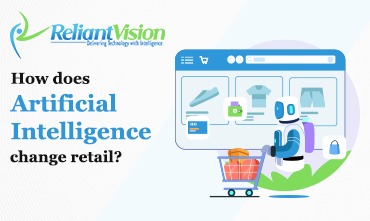You can’t say enough about how important technology is in retail. It is a key part of current retail tactics. In particular, the rise of AI has given the sector new possibilities. For example, AI solutions for retail are improving the customer experience, making supply lines more efficient, and driving sales growth. Let’s figure out how AI is changing the way people shop together.
AI’s Most Important Parts
Artificial Intelligence, or AI, is when tools, especially computer systems, try to act smart like humans. Among these are learning, thinking, and self-correction.
AI in retail is the use of machine learning algorithms, predictive analytics, and other automatic processes to improve business, customer experiences, and decision-making in the retail sector.
How AI is used in the retail business
AI has a lot of promise, and there are several key ways it can be used in retail:
1. Inventory Management and Demand Forecasts: AI has had a big effect on both inventory management and demand forecasts in the retail business. Machine learning systems can look at past sales data and other factors that affect demand to make accurate predictions about what people will want in the future. This makes it less likely that you’ll run out of stock or have too much, so you’ll always have the right amount of stock.
2. Personalized customer experiences: AI-powered shopping experiences are changing how stores connect with customers. With AI, businesses can look at a huge amount of data to figure out how each customer acts and what they like. This information can be used to make specific product suggestions, give custom deals, and make marketing efforts that reach the right people.
3. Online helpers and chatbots: Virtual helpers and robots that are powered by AI are becoming more popular in shopping, and they can help customers 24/7. These tools can help customers in general by answering their questions, giving them information about products, and even helping them buy things online.
4. Pricing Optimization: AI systems can help stores figure out the best prices by looking at factors like demand, competition, and customer buying habits. This leads to higher profit rates while still keeping customers happy.
5. Detecting and stopping fraud: AI in shopping helps to find and stop fake actions. AI can spot possible scams in real time by looking for trends and outliers in transaction data. This protects both stores and users.
AI can help retail stores in many ways.
There are many good things about using AI in shopping. It can improve working efficiency, boost sales, make the customer experience better, and give a business an edge over the competition. AI makes it easier to make decisions based on facts and data. This lets businesses respond quickly to changes in the market, customer tastes, and new trends.
Also, artificial intelligence in retail lets companies make shopping more personal and interesting. With AI, stores can figure out what their customers want and need, make personalized product suggestions, and increase customer trust.
So, it’s clear that AI has the power to change the retail business, and using it is essential for success in the modern retail world. As we learn more about this topic, we’ll find out more about the interesting way AI and shopping are linked.
AI to improve customer experiences
You can’t say enough about how AI is changing the way people shop in stores. Let’s go into more detail about how AI is doing this.
AI and machine learning in retail are making it possible for stores to give customers a highly customized shopping experience:
Product Recommendations Based on Customer Preferences and Behavior: AI systems can look at a lot of customer data, like buying history, viewing habits, and even social media interactions, to figure out what each person likes. With these insights, stores can suggest products to customers in a way that is very specific to them. This gives each customer a unique shopping experience.
Cross-selling and upselling: When AI knows what buyers like and how they shop, it can offer things that go well together or are more expensive. This makes cross-selling and upselling possible. This approach not only improves the shopping experience for the customer, but it also brings in more money for the store.
Ability to do a smart search
When AI was introduced to shopping, it changed the way people look for products:
Voice Search and Natural Language Processing: Voice-enabled search is becoming more common in online shopping thanks to AI and natural language processing (NLP). Customers can use natural-sounding speech requests to look for goods, which makes shopping easier and more fun.
2. Visual Search and Image Recognition: AI also helps with visual search, which means that customers can use photos to look for goods. AI programs can find similar things based on what’s in a picture that’s been shared. This makes shopping easier and more fun.
Augmented Reality and Virtual Try-On
Adding augmented reality (AR) to artificial intelligence in the shopping business makes it much better:
1. Virtual Fitting Rooms and Visualization of goods: Augmented reality, which is driven by AI, lets customers try on goods online or see how they would look in their space. In clothing stores, virtual changing rooms are becoming more common, and furniture stores often have tools that let customers see how a piece would look in their home.
2. Better customer interaction and purchase confidence: These AI solutions for shopping give customers a chance to “try before you buy,” which makes them much more likely to buy. They also give customers more faith in their purchases, which lowers the number of returns and makes customers happier overall.
Final words
Artificial intelligence is changing the way people shop in the retail business by making it more personalized, involved, and fun than ever before. When AI is used in retail, it marks the beginning of a new age of customer-focused selling that matches business goals with customer happiness.

